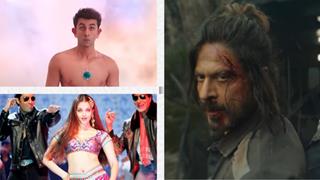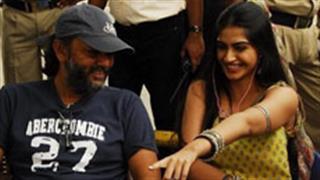The idea came from Rakeysh. He is from Ballimaran which is a part of Delhi 6 - Chandni Chowk area. This was while I was writing Rang De Basanti. He once mentioned his memories of Delhi 6 and the kind of people, issues and behavior, etc.
In fact, I lived with Rakeysh in Delhi while doing the research for the film. I loved the place, its people, the culture and the attitude. People of Delhi 6 still call the soft drink which they serve in restaurants and dhabas, 'Campa Cola'.
The guy will then bring a Pepsi or a Coke. That's what Delhi is about. The city is still trapped in a certain time zone. Rakeysh and I sketched bits and pieces of the city without knowing the fact that we will come out with beautiful film titled Delhi 6.
So what was the basic idea of Delhi 6 you wanted to come out with?
The basic idea of Delhi 6 was that of an NRI boy who comes to India with his grandmother, and like many other NRI's, he too finds the basic infrastructure not present; there is poverty, filth, superstition, etc.
Eventually he hates India but by the end of the film he falls in love with it. Plus there was a love story weaved into the film too. But we thought that the basic idea wasn't enough. We needed something else.
There is a very big statement in Delhi 6 about Americans too, right?
Yes there is. It's about George Bush but we haven't named him. There is this whole big sequence shot in New York about Indians and the Americans which you'll see in the film.
Have you scripted any character in Delhi 6 from the real India?
Yes I have. There are a couple of people in Delhi 6 who are real life inspiration from my village in Allahabad. There is a person called 'Gobar' in Delhi 6 played by Atul Kulkarni who is a real person. I was a kid in my village Balia in Eastern U.P. when I knew him.
He is so fascinating, as a person that I want to write a whole film on him. His real name was different though.
People often ask me that I should pursue direction but I tell them that I am not that greedy. Once you become a director, only one film is there for you in your mind, but as a writer, I am doing almost half a dozen films, animation too.
I have a far richer life, not in terms of money, but in terms of telling stories which no director can claim to have.
 Delhi-6 How many changes did you make in the script of Delhi 6?
Delhi-6 How many changes did you make in the script of Delhi 6? I have lost the count of the drafts. It's strange but true that the final draft of the script wasn't ready and we started the shoot of Delhi 6. I think scripting is a very alive process.
Sometimes, things happen suddenly and unexpected. That's why you have to be always open for changes all the time. A script isn't just a mere piece of paper.
The best reward for a writer is that he is the first audience of his work. Once it goes out of your hands, it belongs to the whole world. You lose it. You relish the moments of its creation.
Relish some moments from Delhi 6 like how the name of the film was born?
There is an interesting story behind this. I and Rakeysh were walking in the night in old Delhi where he was introducing me to the different areas. I was an alien there. While walking, we noticed that there was a fight going on in one of the corners of the street.
During that time, the name of the film wasn't finalised. In fact, the name that we had in mind was revealing the whole story.
Anyway, then one of the boys was getting beaten up by other three and that's when he said, "Haath na lageeyo, Delhi 6 ka launda hoon".
I happened to hear that and told Rakeysh that we found the name of the film. What an attitude that boy had. Delhi 6 isn't just the postal code; it is the identity of the people living in old Delhi and its culture.
But we also hear that the old Delhi was a set, right?
Yes, it was. I went for the shoot to Sambhar in Rajasthan where the re-created the old Delhi. Every sign board in that town was painted with Delhi 6 including the posters of the local Delhi politicians, the banners, etc.
What a great job Sameer Chanda has done. I couldn't recognise that the set was old Delhi. It felt as if we were in Delhi 6.
Delhi-6 Did the same angst make you write Rang De Basanti?
Yes it did. Rang De Basanti started almost fifty years ago. As kids, we once heard Chacha Nehru say, "Anybody who is found corrupt in this country will be hanged by the nearest telephone pole".
So next morning, we kids were going to school and saw all the telephone poles empty. We were so innocent that we believed in Nehru because we loved him beyond our limits.
Forty years later, the telephone poles are still empty. Neither a single politician nor a bureaucrat has been hanged from the nearest telephone pole. That was the angst which made me write Rang De Basanti.
 A true Bharat you are.
A true Bharat you are. Thank you. Well, each of your questions has an interesting story. This one also. Our country isn't called 'Bharat' because of the great king Bharat. 'Bha' means light and 'Rat' means in search of.
Imagine the great people who put the whole meaning of this country into the name. Bharat is a country which is in search of enlightenment and not in search of global domination, fame or economic growth.
Our country has always been in search of light, even today, and that is the real glory of India.
Why should one go and watch Delhi 6?
Because Rakeysh and I have made one of the most unusual films which is so unique and fresh and so Indian. There hasn't been a film lately which is so Indian.
Tell us a bit about the pigeon in the film. Why so prominent on all the posters and hoardings?
(Laughs) The pigeon is there because of Om Puri, who plays Sonam Kapoor's father. What to give him in terms of his role.
Also we wanted to cover the roof tops of old Delhi. There are no sky scrappers in old Delhi and the roof tops make the most fascinating visuals in the mornings and the evenings. So how do you use the roof tops was the question.
Then again, the pigeon is also a metaphor for Sonam Kapoor who wants to escape that environment. Om Puri's role in the film is to take care of the pigeons and feed them. It's a tradition which still exists in India.
















